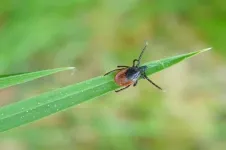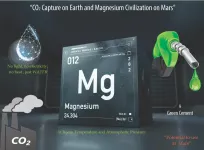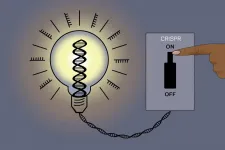(Press-News.org) Auroral displays continue to intrigue scientists, whether the bright lights shine over Earth or over another planet. The lights hold clues to the makeup of a planet's magnetic field and how that field operates.
New research about Jupiter proves that point -- and adds to the intrigue.
Peter Delamere, a professor of space physics at the University of Alaska Fairbanks Geophysical Institute, is among an international team of 13 researchers who have made a key discovery related to the aurora of our solar system's largest planet.
The team's work was published April 9, 2021, in the journal Science Advances. The research paper, titled "How Jupiter's unusual magnetospheric topology structures its aurora," was written by Binzheng Zhang of the Department of Earth Sciences at the University of Hong Kong; Delamere is the primary co-author.
Research done with a newly developed global magnetohydrodynamic model of Jupiter's magnetosphere provides evidence in support of a previously controversial and criticized idea that Delamere and researcher Fran Bagenal of the University of Colorado at Boulder put forward in a 2010 paper -- that Jupiter's polar cap is threaded in part with closed magnetic field lines rather than entirely with open magnetic field lines, as is the case with most other planets in our solar system.
"We as a community tend to polarize -- either open or closed -- and couldn't imagine a solution where it was a little of both," said Delamere, who has been studying Jupiter since 2000. "Yet in hindsight, that is exactly what the aurora was revealing to us."
Open lines are those that emanate from a planet but trail off into space away from the sun instead of reconnecting with a corresponding location in the opposite hemisphere.
On Earth, for example, the aurora appears on closed field lines around an area referred to as the auroral oval. It's the high latitude ring near -- but not at -- each end of Earth's magnetic axis.
Within that ring on Earth, however, and as with some other planets in our solar system, is an empty spot referred to as the polar cap. It's a place where magnetic field lines stream out unconnected -- and where the aurorae rarely appear because of it. Think of it like an incomplete electrical circuit in your home: No complete circuit, no lights.
Jupiter, however, has a polar cap in which the aurora dazzles. That puzzled scientists.
The problem, Delamere said, is that researchers were so Earth-centric in their thinking about Jupiter because of what they had learned about Earth's own magnetic fields.
The arrival at Jupiter of NASA's Juno spacecraft in July 2016 provided images of the polar cap and aurora. But those images, along with some captured by the Hubble Space Telescope, couldn't resolve the disagreement among scientists about open lines versus closed lines.
So Delamere and the rest of the research team used computer modeling for help. Their research revealed a largely closed polar region with a small crescent-shaped area of open flux, accounting for only about 9 percent of the polar cap region. The rest was active with aurora, signifying closed magnetic field lines.
Jupiter, it turns out, possesses a mix of open and closed lines in its polar caps.
"There was no model or no understanding to explain how you could have a crescent of open flux like this simulation is producing," he said. "It just never even entered my mind. I don't think anybody in the community could have imagined this solution. Yet this simulation has produced it."
"To me, this is a major paradigm shift for the way that we understand magnetospheres."
What else does this reveal? More work for researchers.
"It raises many questions about how the solar wind interacts with Jupiter's magnetosphere and influences the dynamics," Delamere said.
Jupiter's aurorally active polar cap could, for example, be due to the rapidity of the planet's rotation -- once every 10 hours compared to Earth's once every 24 hours -- and the enormity of its magnetosphere. Both reduce the impact of the solar wind, meaning the polar cap magnetic field lines are less likely to be torn apart to become open lines.
And to what extent does Jupiter's moon Io affect the magnetic lines within Jupiter's polar cap? Io is electrodynamically linked to Jupiter, something unique in our solar system, and as such is constantly stripped of heavy ions by its parent planet.
As the paper notes, "The jury is still out on the magnetic structure of Jupiter's magnetosphere and what exactly its aurora is telling us about its topology."
INFORMATION:
ADDITIONAL CONTACT:
Peter Delamere,
University of Alaska Fairbanks Geophysical Institute,
padelamere@alaska.edu
NOTE TO EDITORS:
The paper will be available online at https://www.eurekalert.org/pio/tipsheetdoc.php/1/Zhang210409.pdf
For the first time, researchers have been able to obtain data from underneath Thwaites Glacier, also known as the "Doomsday Glacier". They find that the supply of warm water to the glacier is larger than previously thought, triggering concerns of faster melting and accelerating ice flow.
With the help of the uncrewed submarine Ran that made its way under Thwaites glacier front, the researchers have made a number of new discoveries. Professor Karen Heywood of the University of East Anglia commented:
"This was Ran's first venture to polar regions and her exploration of the waters under the ice shelf was much more successful than we had dared to hope. We plan to build on these exciting findings ...
Tick-borne encephalitis is a disease just as nasty as it sounds. Once bitten by an infected tick, some people develop flu-like symptoms that resolve quietly but leave behind rampant neurological disease--brain swelling, memory loss, and cognitive decline. Cases are on the rise in Central Europe and Russia with some 10,000 incidents reported each year. Vaccines can provide protection, but only for a limited time. There is no cure.
Now a new study describes antibodies capable of neutralizing the virus transmitted by tick bites. These so-called broadly neutralizing antibodies have shown promise in preventing TBE in mice and could inform the development of better vaccines for humans. ...
Children may not be as infectious in spreading SARS-CoV-2 to others as previously thought, according to new University of Manitoba-led research in CMAJ (Canadian Medical Association Journal).
"Our findings have important public health and clinical implications," writes principal investigator Dr. Jared Bullard, associate professor, pediatrics/child health and medical microbiology/infectious diseases, Max Rady College of Medicine, University of Manitoba and associate medical director, Cadham Provincial Laboratory in Winnipeg, Manitoba. "If younger children are less capable of transmitting infectious virus, daycare, in-person school and cautious extracurricular activities may be safe to continue, with appropriate precautions in place, ...
When setting SARS-CoV-2 vaccine priorities, Canada should take a more nuanced approach that considers geographic and occupational risk exposures, as 75% of Canadian adults have at least 1 risk factor for severe COVID-19, argues an analysis in CMAJ (Canadian Medical Association Journal).
"Using risk factors for severe COVID-19 in a strategic vaccination strategy may not offer much refinement because of how widespread these conditions are. More detailed weighting of medical, geographic and occupational risks might be required if vaccination is constrained," writes Dr. Finlay McAlister, Faculty of Medicine & Dentistry, University of Alberta, Edmonton, Alberta, with coauthors. "In particular, since the third wave of the COVID-19 pandemic appears ...
Excessive CO2 emissions are a major cause of climate change, and hence reducing the CO2 levels in the Earth's atmosphere is key to limit adverse environmental effects. Rather than just capture and store CO2, it would be desirable to use it as carbon feedstock for fuel production to achieve the target of "net-zero-emissions energy systems". The capture and conversion of CO2 (from fuel gas or directly from the air) to methane and methanol simply using water as a hydrogen source under ambient conditions would provide an optimal solution to reduce excessive CO2 ...
BOSTON -- Videos of people experiencing severe neurological symptoms, including convulsions and difficulty walking, purportedly after receiving a COVID-19 vaccine, have surfaced on Facebook, YouTube and other social media channels. The millions of people watching these videos might conclude that the vaccine is either quite dangerous to produce such symptoms or that the people in the videos are faking their symptoms. Both conclusions are incorrect, according to neurologist and psychiatrist David Perez, MD, MMSc, director of the Functional Neurological Disorders Unit at Massachusetts General Hospital (MGH).
In a JAMA Neurology Viewpoint, the authors explain that the COVID-19 vaccine may precipitate the development of functional neurological disorder (FND), a neuropsychiatric disorder with ...
Study: "How Do Weighted Funding Formulas Affect Charter School Enrollments?"
Author: Paul Bruno (University of Illinois at Urbana-Champaign)
This study was presented today at the American Educational Research Association's 2021 Virtual Annual Meeting.
Main Findings:
The adoption of a school funding system in California that increased revenues for schools enrolling higher-need students led to an increase in the rate at which charter schools enrolled low-income students.
This effect was concentrated among charter schools initially enrolling low-income students at relatively low rates, suggesting that some charters "cream skim" high achieving, wealthier students, but that such behavior also can be mitigated.
Details:
For many, the expansion of charter schooling since the early ...
It's time for a more nuanced approach to vaccine prioritization, as more contagious COVID-19 variants become prevalent and a third wave of infections threatens to overwhelm hospitals in some provinces, according to an END ...
Over the past decade, the CRISPR-Cas9 gene editing system has revolutionized genetic engineering, allowing scientists to make targeted changes to organisms' DNA. While the system could potentially be useful in treating a variety of diseases, CRISPR-Cas9 editing involves cutting DNA strands, leading to permanent changes to the cell's genetic material.
Now, in a paper published online in Cell on April 9, researchers describe a new gene editing technology called CRISPRoff that allows researchers to control gene expression with high specificity while leaving the sequence of the DNA unchanged. Designed by Whitehead Institute Member Jonathan Weissman, University of California San Francisco assistant professor Luke Gilbert, Weissman lab postdoc James Nuñez and collaborators, ...
What The Study Did: This survey study examines wh0 U.S. adults believe should be prioritized for access to COVID-19 vaccines.
Authors: Ezekiel J. Emanuel, M.D., Ph.D., of the University of Pennsylvania Perelman School of Medicine in Philadelphia, is the corresponding author.
To access the embargoed study: Visit our For The Media website at this link https://media.jamanetwork.com/
(doi:10.1001/jamanetworkopen.2021.7943)
Editor's Note: The article includes conflict of interest and funding/support disclosures. Please see the article for additional information, including other authors, author contributions and affiliations, conflict of interest and financial disclosures, and funding and support.
INFORMATION:
Media advisory: The ...




